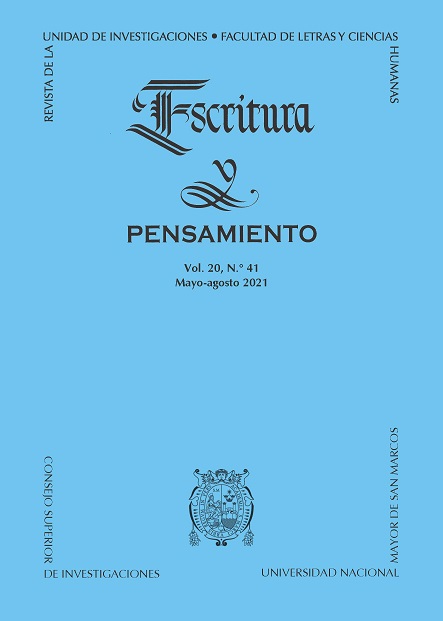Jorge Cafrune: Migrate to one´´´´´´´´´s own death
DOI:
https://doi.org/10.15381/escrypensam.v20i41.21117Keywords:
migration, displaced authorship, performance, popular folkloreAbstract
The following work proposes a reading of the migrant figure of the singer Jorge Cafrune from the chronicle of Jimena Néspolo (2018) Who killed Cafrune? Chronicle of the death of the militant song. From different points of view, we find in this emblem of popular folklore the figure of migration not only as a physical / spatial displacement, but also from his writings (the lyrics of his songs), and from his performative capacity. Migration, for this displaced author, is also read as an ideological factor, a motor for other possible displacements and their consequences.
References
Altuna, E. (2016). Pedro Lemebel: Crónicas de la orfandad urbana. En Altuna y Campuzano (Comp.). Vertientes de la Contemporaneidad. Salta: EUNSa.
Angenot, M. y Robin, R. (1988). La inscripción del discurso social en el texto literario. Sociocriticism, 1. (mimeo)
Bocchino, A. (2006). Exilio y desafío teórico: cuando la escritura hace lugar al autor”. Orbis Tertius, año XI, N° 12. Universidad Nacional de La Plata.
Bueno, R. (2004). Antonio Cornejo Polar y los avatares de la cultura latinoamericana. Lima: Fondo Editorial de la Universidad Mayor de San Marcos.
Cornejo Polar, A. (2002) Escribir en el Aire. Lima: CELACP
Franco Carvalhal, T. (1996) Literatura Comparada. Buenos Aires: Corregidor.
Néspolo, J. (2018) ¿Quién mató a Cafrune? Crónica de la muerte de la canción militante. Buenos Aires: Tinta Limón.
Nucera, D. (2002) Los viajes y la literatura. En Gnisci, A. (Comp.). Introducción a la Literatura Comparada. Barcelona: Crítica.
Kristeva, J. (1978) Semiótica. Buenos Aires: Fundamentos.
Williams, R. (2009) Marxismo y Literatura. Buenos Aires: Las Cuarenta.
Downloads
Published
Issue
Section
License
Copyright (c) 2021 Luciana Arriaga

This work is licensed under a Creative Commons Attribution 4.0 International License.
AUTHORS RETAIN THEIR RIGHTS:
a. The authors retain their trademark and patent rights, and also over any process or procedure described in the article.
b. The authors retain the right to share, copy, distribute, execute and publicly communicate the article published in the Escritura y Pensamiento (for example, place it in an institutional repository or publish as part a book), with acknowledgment of its initial publication by Escritura y Pensamiento.
c. Authors retain the right to make a subsequent publication of their work, to use the article or any part of it (for example: a compilation of their work, lecture notes, thesis, or for a book), provided that they indicate the source of publication (authors of the work, journal, volume, number and date).





